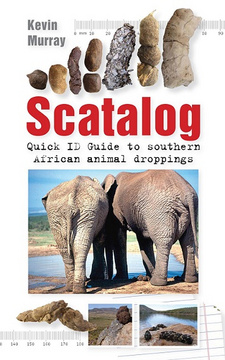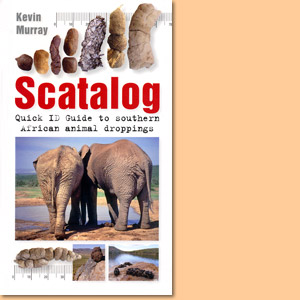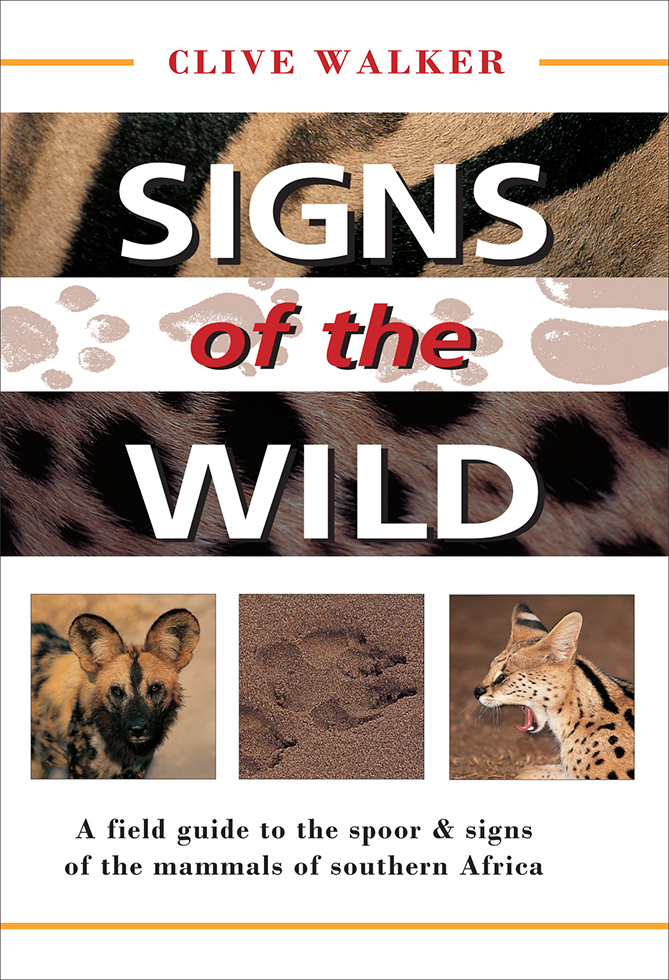Scatalog: Quick ID guide to Southern African animal droppings, by Kevin Murray
Scatalog, a identification guide to Southern African animal droppings makes it easy to identify animal scats, droppings, faeces or dung. Author is Kevin Murray.
There is basic information on how to distinguish between the main animal groups; and more detailed information (and many photographs showing actual size) on about 100 individual species. These include mammals, birds, reptiles, insects and frogs. Remember that animals will not have read the rules contained in this guide! Expect to see variation. Use your common sense. Have fun. And be safe: animal scats can transmit diseases, worms and parasites, so avoid handling them.
How to use this guide: The photos are the simplest identification tools. They show typical, well-formed scats. Many photos are actual size; those that are not show a scale of either 5 or 10 cm. Remember that much variation in shape can occur. Also, some scats, such as those of antelope, can be difficult to tell apart, so other knowledge and further observations are often necessary for identification. Based on the scat shape, and once scat attributes have been closely observed, choose the appropriate table (pages 15 and 22-23). Perhaps the most easily identified shape is the pellet, typically produced by the giraffe and by antelope in general. The first table covers antelope (and giraffe) pellets. The second table covers scats that do not have this pellet shape. Note that this guide contains some animal scats that do not occur in the tables; and that the tables also contain information on some animals for which there are no photos. Therefore, always consult both the tables and the photos.
- Try to separate and measure individual units if they are attached in a clump. Measurements in the tables refer to adult animals, so bear in mind that you may be observing a young animal's scat. If the animal has produced a soft, runny mass then forget about measurements. Rather concentrate on observing contents and location features. Width (mm): Measure width where the scat is widest. Compare this with the average and maximum widths in the appropriate table, establishing a preliminary shortlist of possible animals. Length (mm): Length refers to the longest axis. If the scat has a point, length is measured from that point. Check the maximum length against that in your shortlist but don't be surprised if it falls outside the indicated ranges because length can be extremely variable. Width is usually a much more reliable measure than length.
- Analyse the contents: these indicate diet, which can be very characteristic for some animals. If contents are not easily visible, break open the scat with a stick. Identification of contents can be difficult but useful clues can sometimes be found. Remember that finding hair in scat can be misleading - it may be the animal's own hair, ingested during self-grooming, not that of a prey animal.
- Observe the location features: some animals use the same location many times, creating a latrine site or midden. A few animals deposit their scat in a prominent place, such as on a clump of grass, on a stone or rock, or even on top of an antelope midden. A few bury their scats, or at least attempt to, with varying degrees of success. Some, like rhino and male hippo, deliberately break up and scatter their scats.
- Draw up a shortlist of possible animals by using the suggested measurements and observations, teamed with all other available information (such as likely occurrence of the animal in the general area, the specific habitat, any spoor and other field signs). A knowledge of typical animal behaviour helps determine which animals might be present in the area.
- Persist and be patient: the considerable variation that occurs in scat shapes, sometimes for an individual animal, makes identification difficult - even for the more experienced tracker. However, with practice and using the guidelines, we can make educated guesses as to scat identity, even if our best efforts are to say 'it's an antelope the size of an impala' or 'it's a caracal or a young leopard'.
- Connect through knowledge: Our lives nowadays are sadly disconnected from the natural environment upon which we depend so intimately. Anything that helps us connect adds depth and meaning, broadening our awareness and understanding of the natural world around us. Identifying the scat of an animal immediately connects us with that animal, whether in our cities, our villages, our farms or in the wild. Animal scats reveal which fellow travellers have been our way, and when.
This is an excerpt from the guide: Scatalog. Quick ID guide to Southern African animal droppings, by Kevin Murray.
Title: Scatalog. Quick ID guide to Southern African animal droppings
Author: Kevin Murray
Publisher: Random House Struik
Imprint: Struik Nature
Cape Town, South Africa 2011
ISBN 9781770079557
Softcover, 11x18 cm, 36 pages, throughout colour photographs
Murray, Kevin im Namibiana-Buchangebot
Scatalog: Quick IDs guide to Southern African animal droppings
Scatalog is a quick and quirky identification guide to Southern African animal dung or droppings.
Weitere Buchempfehlungen
Diving and spearfishing in South Africa
This new edition of Diving and Spearfishing in South Africa will appeal to both novice and seasoned spearfishers.
Signs of the wild. A field guide to the spoor and signs of the mammals of southern Africa
Clive Walker's tracking guide Signs of the wild focusses on spoor and signs of the mammals of southern Africa.




